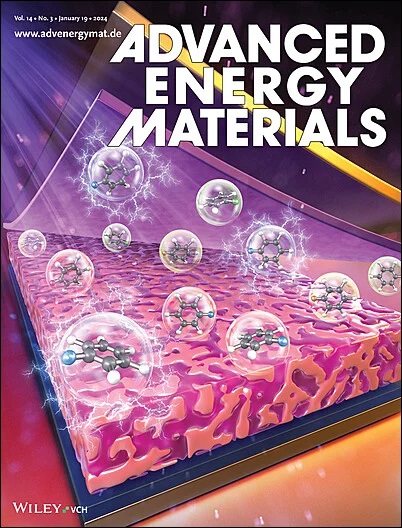Carbon‐Encapsulated CeO2‐Co Heterostructure via Tight Coupling Enables Corrosion‐Resistant Bifunctional Catalysis in Zinc‐Air Battery
IF 24.4
1区 材料科学
Q1 CHEMISTRY, PHYSICAL
引用次数: 0
Abstract
Developing efficient bifunctional electrocatalysts for oxygen reduction (ORR) and oxygen evolution reactions (OER) is crucial to enhancing rechargeable zinc‐air batteries (ZABs). Here, a rationally designed catalyst consisting of nitrogen‐doped porous carbon‐encapsulated cobalt nanoparticles coupled tightly with CeO碳包封CeO2 - Co异质结构通过紧密耦合实现锌-空气电池的耐腐蚀双功能催化
开发用于氧还原(ORR)和析氧反应(OER)的高效双功能电催化剂是提高可充电锌空气电池(ZABs)性能的关键。本文报道了一种合理设计的催化剂,该催化剂由氮掺杂多孔碳封装的钴纳米颗粒与CeO2纳米颗粒(CoNPs/NC/CeO2)紧密耦合组成,具有优异的双功能性能。原位拉曼和ATR - FTIR光谱分析表明,位于钴纳米粒子附近的CeO2纳米粒子作为电子调节剂,在OER过程中抑制金属Co不可逆氧化成CoOOH,同时在随后的ORR过程中促进其可逆还原回Co。此外,CeO2还能有效清除活性氧,显著提高催化稳定性。由于Co和CeO2在碳基体内的协同作用,CoNPs/NC/CeO2在10,000次循环后实现了0.86 V(相对于RHE)的高ORR半波电位(E₁/ 2),性能损失最小(18 mV), 10 mA cm - 2时的OER过电位仅为230 mV,双功能电位差(ΔE)为0.60 V,超过了商用Pt/C + RuO2。当作为阴极应用于实际的ZABs时,该催化剂具有优异的比容量(814.7 mAh gZn−1),峰值功率密度(254.6 mW cm−2),以及超过2200小时的卓越循环耐久性。
本文章由计算机程序翻译,如有差异,请以英文原文为准。
求助全文
约1分钟内获得全文
求助全文
来源期刊

Advanced Energy Materials
CHEMISTRY, PHYSICAL-ENERGY & FUELS
CiteScore
41.90
自引率
4.00%
发文量
889
审稿时长
1.4 months
期刊介绍:
Established in 2011, Advanced Energy Materials is an international, interdisciplinary, English-language journal that focuses on materials used in energy harvesting, conversion, and storage. It is regarded as a top-quality journal alongside Advanced Materials, Advanced Functional Materials, and Small.
With a 2022 Impact Factor of 27.8, Advanced Energy Materials is considered a prime source for the best energy-related research. The journal covers a wide range of topics in energy-related research, including organic and inorganic photovoltaics, batteries and supercapacitors, fuel cells, hydrogen generation and storage, thermoelectrics, water splitting and photocatalysis, solar fuels and thermosolar power, magnetocalorics, and piezoelectronics.
The readership of Advanced Energy Materials includes materials scientists, chemists, physicists, and engineers in both academia and industry. The journal is indexed in various databases and collections, such as Advanced Technologies & Aerospace Database, FIZ Karlsruhe, INSPEC (IET), Science Citation Index Expanded, Technology Collection, and Web of Science, among others.
 求助内容:
求助内容: 应助结果提醒方式:
应助结果提醒方式:


